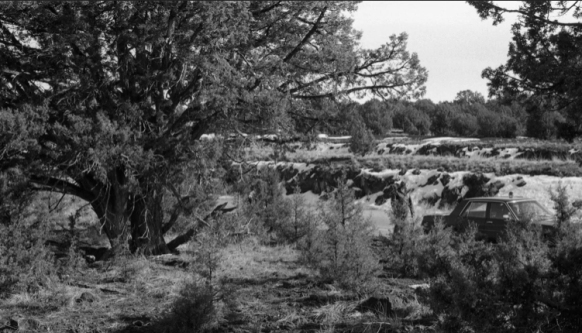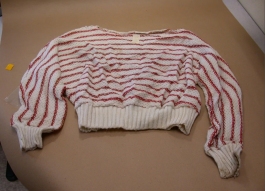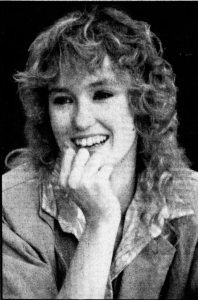18 December 1947 was a cold winter’s morning like any other in Tucumcari. Bertha Eugene Wagnon Kappel had got up at 4.45am to prepare for her shift at the Home Café in the Vorenberg Hotel. (The Vorenberg was a grand hotel in downtown Tucumcari which boasted suites with private baths, a large lobby, dining room and barber shop as well as the Home Café. After the First World War it was owned by Floyd B Redman who built quite a property portfolio over the years. In the 1950s he bought another motel which was managed by a lady called Lillian Leigon; romance blossomed and he presented the motel to her as an engagement present. The motel was the famous Blue Swallow.)

The Vorenberg Hotel. The Home Cafe where Bertha Kappel was employed can be seen at the right.
Bertha had only been working at the Home Café for a couple of months while her husband Gus Adolph did various odd jobs. They had been married in Oklahoma in 1938 but several of the family – Bertha was one of 13 children – had moved to Tucumcari where Adolph also had links. They and their daughter were staying with Bertha’s brother, Roy, and his wife Catalina, in Roy’s home on North 1st Street, although the Kappels had purchased a lot nearby on which they intended to build a rudimentary house. To this end, Bertha had bought some lumber and, after finishing work on 17 December, she visited the lot to inspect progress. She found that the lumber was missing and this set into inexorable motion the events of the next few hours.
Bertha returned to her brother’s house and accused Adolph of selling the materials. He denied it but she discovered that he had, in fact, sold the lumber to a neighbour and, even worse, he hadn’t been paid for it. Bertha told him to get the lumber back within three days or “she would turn him in”. Now, the lumber may have been from a dubious source and Kappel did have a prior conviction for theft, so it might have been a well-aimed threat on her part. The quarrel continued into the evening although Adolph would later claim that the couple had been made up by the time they went to bed.
Even before the lumber incident it doesn’t appear to have been a happy marriage. Bertha had moved to Tucumcari some eight months before while her husband tried to find work in Oregon. When he returned to New Mexico she had sworn out a warrant on him for non-support of their 12-year-old daughter, Mary Frances.
Unsurprisingly next morning, the arguing flared up again when Adolph was slow to accompany Bertha on her walk to work. She left the house without him and when he called out to her to wait, she replied; “You dirty son-of-a-bitch, if you are going with me, come on.” It was an unfortunate choice of words and Bertha probably knew that it was a term that particularly offended her husband.
At around 6am, near an overpass, the body of Bertha Kappel was discovered just three blocks from her brother’s house. She lay in a pool of blood, her head cracked open by three blows from an axe and her left ear almost severed. When she was found, Kappel was taking a nap, having returned home, vomited and then taken two aspirins for a headache and then slept for an hour. When he woke up, he had a hearty breakfast and then went to the Home Café to say that his wife wouldn’t be coming to work that day. He was then arrested close to where Bertha’s body lay.

Adolph Kappel had a limited mental capacity but he knew enough to get rid of the axe, tossing it onto the roof of a neighbour’s house where it was later found. He signed a confession, saying that he had no recollection of killing his wife but remembered “I was standing over her and I struck a match and seen what I had done.” At his trial, he was charged with first degree murder and the jury took less than an hour to find him guilty. He was sentenced to be executed in New Mexico’s electric chair.
Kappel appealed and was granted a second trial on the grounds that the jury had not been given the option of convicting him of second degree murder. This jury decided that the murder had been conducted in the heat of the moment and was not planned or deliberate. He was once again found guilty but this time the sentence was 90-99 years rather than death. Kappel proved to be a model prisoner – for at least a year…

Gus Adolph Kappel
Assigned to a prison work gang at the penitentiary’s clay pits, on the last day of October 1950, Adolph Kappel made his escape aboard a black mule called Pete (one newspaper reported the beast was called Pegasus which seems a little fanciful). For five days he managed to stay ahead of police and prison guards in freezing cold weather until he was finally captured 35 miles south east of Las Vegas, New Mexico. He gave various reasons for his escape, saying that he had wanted to find out why he hadn’t heard from his daughter and believed that his brother was preventing her from writing to him. He also said he wanted to see his sister-in-law who had been involved in a road accident and then intended on going to Oklahoma to visit his mother and other relatives. But he also told reporters that “I am not the man who killed my wife” and that had he been able to get to Tucumcari he “could have cleaned up the whole mess”. Given that he had signed a confession which formed the basis of his first trial and pleaded guilty to second degree murder at the second trial it’s difficult to see how anyone else might have killed Bertha.
In 1953, Governor Edwin Mechem commuted Kappel’s sentence to a flat 70 years while the Warden commented, perhaps a little tongue in cheek, that Kappel was “now a plumber. He does not have access to a mule”.

Governor Erwin L Mechem who commuted Adolph Kappel’s 90-99 sentence to 70 years.
Adolph Kappel applied for parole at every chance and was denied for many years. When was he released? The short answer; I don’t know. He died in 1978 at the age of 63 and is buried in the Santa Fe National Cemetery. However, he was also incarcerated in the Penitentiary of New Mexico which is just 15 miles from Santa Fe but I found that he had won a newspaper competition in 1976 when living in Ojo Caliente near Taos so it appeared he stayed in the area after his release. Perhaps he just had nowhere else to go.

John Frederick Kappel whose bound body was found in a Sayre lake in an unsolved homicide.
It is perhaps a little ironic that, with one brother behind bars for homicide, another brother should also meet his end by murder. In September 1963, the youngest Kappel son, John Frederick, was found floating in a pond in Sayre, Oklahoma. This was no natural drowning; John’s hands and feet were tied and he had also suffered a blow on the head before being thrown into the lake to drown. He had previously been working as a union picket for the International Hod Carriers, Building and Common Laborers Union protesting at the construction site for a grocery store in Elk City. Police stated that his job had nothing to do with his death, although they were bemused at the lack of signs of a struggle as John was a large man – 6’4” and 240lbs as well as being a karate expert – and throwing him in the pond had required lifting him over a barbed wire fence. The case was never solved.

The lower walls are all that remains of the Vorenberg Hotel after a fire in the 1970s. The house where Bertha and Adolph were living with her brother is also long gone.
















 On Valentine’s Day 1982, as people waited expectantly for the mail or for a florist delivery, a Arizona Department of Public Safety officer was looking for a blown out tyre shed by a motorist on Interstate 40 eleven miles outside of Williams, Arizona. It was a cold and frosty morning, the temperature just above freezing when, just 25 feet from the interstate, he came across a girl face down under a tree. He knew immediately she wasn’t just sleeping – not in the cold and wearing only jeans – and just one glance at the decomposition of the body and the damage wreaked by animals on her face and right ear was enough to send him scrambling for his radio. And so began a mystery which haunts the Coconino County Sheriff’s Office to this day.
On Valentine’s Day 1982, as people waited expectantly for the mail or for a florist delivery, a Arizona Department of Public Safety officer was looking for a blown out tyre shed by a motorist on Interstate 40 eleven miles outside of Williams, Arizona. It was a cold and frosty morning, the temperature just above freezing when, just 25 feet from the interstate, he came across a girl face down under a tree. He knew immediately she wasn’t just sleeping – not in the cold and wearing only jeans – and just one glance at the decomposition of the body and the damage wreaked by animals on her face and right ear was enough to send him scrambling for his radio. And so began a mystery which haunts the Coconino County Sheriff’s Office to this day.













